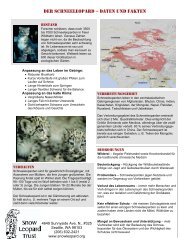Download the 7 Mb PDF file - Snow Leopard Trust
Download the 7 Mb PDF file - Snow Leopard Trust
Download the 7 Mb PDF file - Snow Leopard Trust
Create successful ePaper yourself
Turn your PDF publications into a flip-book with our unique Google optimized e-Paper software.
Engaging Students in Conservation<br />
52<br />
10. Have students read about <strong>the</strong>ir goal<br />
toge<strong>the</strong>r and brainstorm possible<br />
solutions to <strong>the</strong> issue.<br />
11. Have <strong>the</strong>m discuss and complete <strong>the</strong><br />
handouts Creating Sustainable Solutions<br />
and <strong>the</strong> Skit Graphic Organizer with <strong>the</strong>ir<br />
group members. Share with <strong>the</strong> class <strong>the</strong><br />
assessment rubric to help <strong>the</strong>m prepare<br />
<strong>the</strong>ir skits.<br />
Activity – Day 2<br />
Core Activity: Presentations<br />
(40 minutes)<br />
1. Have student groups present <strong>the</strong>ir<br />
skits while o<strong>the</strong>r students watch and<br />
take notes on <strong>the</strong> solutions suggested<br />
in <strong>the</strong> skits. Encourage students to ask<br />
questions about each o<strong>the</strong>r’s solutions<br />
after <strong>the</strong> skits have been presented.<br />
2. After all groups have presented, lead a<br />
short discussion using some or all of <strong>the</strong><br />
following questions.<br />
Discussion<br />
1. Were <strong>the</strong>re any conflicts in your group<br />
you had to resolve in order to reach <strong>the</strong><br />
proposed solution?<br />
2. Why does considering multiple<br />
perspectives help to make a solution<br />
more sustainable?<br />
TOM MCCARTHY<br />
What’s <strong>the</strong> Plan?<br />
3. Why would a solution that supports<br />
snow leopards, but not humans, be<br />
unsustainable?<br />
4. Were any of <strong>the</strong> proposed solutions not<br />
necessarily sustainable? How could <strong>the</strong>y<br />
be made more sustainable?<br />
5. Are <strong>the</strong> proposed solutions that each<br />
group suggested mutually exclusive, or<br />
could any of <strong>the</strong>m work toge<strong>the</strong>r? How?<br />
6. How would you revise your solution now<br />
that you have heard o<strong>the</strong>rs?<br />
Wrap Up: Making Connections<br />
(10 minutes)<br />
1. Have students form a large circle in a<br />
cleared area.<br />
2. Pass out one <strong>Snow</strong> <strong>Leopard</strong> Connections<br />
Card to each student. For classes with<br />
more than 16 students, do this activity in<br />
pairs.<br />
3. Have students affix <strong>the</strong> cards to <strong>the</strong>ir<br />
shirts or hold <strong>the</strong>m where everyone can<br />
see.<br />
4. Tell students <strong>the</strong>ir task is to connect<br />
different issues related to snow leopards.<br />
5. Hand <strong>the</strong> ball of yarn to one student and<br />
have him/her read his/her card out loud.<br />
6. Have this student pass <strong>the</strong> ball of yarn<br />
(while still holding on to <strong>the</strong> end) to<br />
ano<strong>the</strong>r student.<br />
© FACING THE FUTURE www.facing<strong>the</strong>future.org & SNOW LEOPARD TRUST www.snowleopard.org<br />
4




